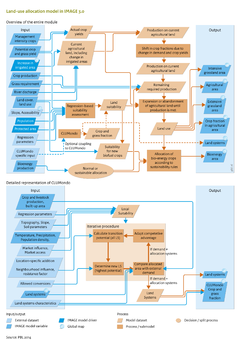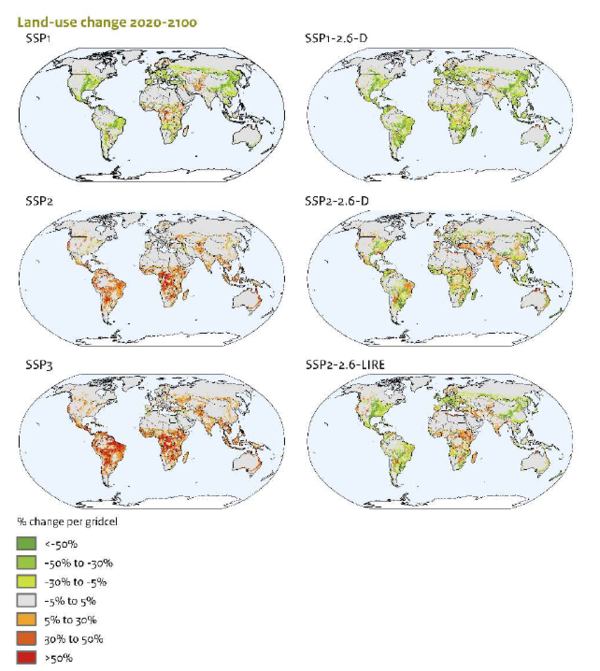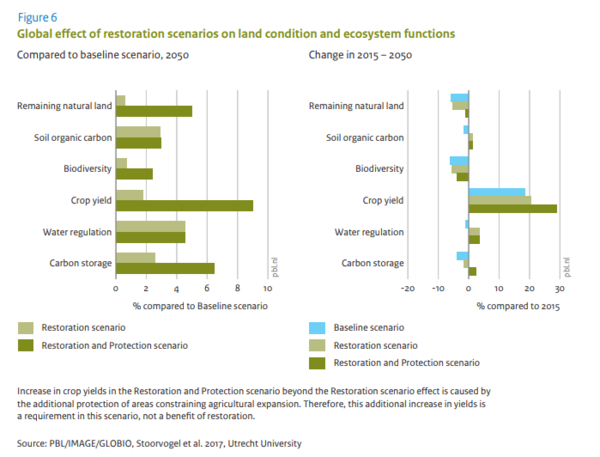Land-use allocation/Policy issues
Parts of Land-use allocation/Policy issues
| Component is implemented in: |
| Components: |
| Related IMAGE components |
| Projects/Applications |
| Key publications |
Baseline developments
In a baseline scenario, agricultural land use may expand or decrease dependent on underlying scenario drivers and assumptions: in a SSP2 business-as-usual scenario substantial increases in agricultural land use take place leading to strong conversion of natural land. An SSP3 world shows even more conversion due to stronger population growth and very limited protection measures for nature and biodiversity. In the more sustainability oriented scenario SSP1 a major reduction takes place related to lower population, extensive protection of natural land and reduced consumption of animal products. The land-use allocation model is used to indicate where these changes may occur. Thus, it helps to assess the consequence of agricultural expansion and intensification on the environment, for example in relation to biodiversity, carbon storage, and water availability.
Policy interventions
The policy interventions that can be analysed are related to either the agricultural economy (Agricultural economy), or they are reflected in the allocation rules used in the land-use allocation module (e.g. more protected areas, REDD+ schemes). In a study for the Global Land Outlook (van der Esch et al., 2021) the impacts of extensive protected area and the effect restoration (reverting agricultural land productivity loss) were compared. The results show that protection has especially strong effects on natural land, biodiversity and carbon storage. Crop yields also increase as a necessity to produce more on less land, however other studies show that this also negatively impacts food security (van Meijl et al., 2020b; Hasegawa et al., 2018).
Effects of policy interventions on this component
| Policy intervention | Description | Effect |
|---|---|---|
| Agricultural trade policies | Changes in agricultural trade policies are applied to the corresponding quota (export or import quota) or border taxes. (Reference:: Verburg et al., 2009) | Due to changed production in agricultural commodities, land use for agriculture within a region will change. |
| Change in grazing intensity (*) | Change in grazing intensity, usually more intensive. This would require better management of grasslands, including for example the use of grass-clover mixtures and fertilisers, bringing the length of the grazing season in tune with the period of grass production, and rotations. | More intensive grassland management decrease the area needed for grassland, while producing the same amount of grass and/or feeding the same size of livestock. |
| Changes in consumption and diet preferences | Interventions that target consumption changes or changes in dietary preferences (Reference:: Stehfest et al., 2013) | Changes in production of agricultural commodities within a region change the land use for agricultural purposes (both total area for agriculture and the ratio of grass to crop area). |
| Enlarge protected areas (*) | Increase in areas with protected status, as well the size of the areas as the numer of parks. (Reference:: PBL, 2010) | Agriculture is not allowed in protected areas and therefore is allocated at other locations. |
| Implementation of biofuel targets | Policies to enhance the use of biofuels, especially in the transport sector. In the Agricultural economy component only 'first generation' crops are taken into account. The policy is implemented as a budget-neutral policy from government perspective, e.g. a subsidy is implemented to achieve a certain share of biofuels in fuel production and an end-user tax is applied to counterfinance the implemented subsidy. (Reference:: Banse et al., 2008) | Targets for biofuel production/blending impact agricultural production and consequently land use. |
| Implementation of land use planning (*) | Application of zoning laws or cadastres, assigning areas to certain land uses. | Could affect allocation of agriculture, in case agriculture is excluded in some areas. |
| Increased livestock productivity | A change in production characteristics, such as milk production per animal, carcass weight and off-take rates, which will also have an impact on the feed conversion ratio; in general, this will be lower in more productive animals | A change in feed crop and grass requirements results in changes in land use, e.g. grasslands and cropping areas. |
| Intensification or extensification of livestock systems | A change in the distribution of the production over pastoral and mixed systems; usually to a larger share of the production in mixed systems, which inherently changes the overall feed conversion ratios of ruminants. | An intensification of livestock systems decreases the average area needed per animal (in land using livestock systems) |
| Intensification/extensification of livestock systems | A change in the distribution of the production over pastoral and mixed systems; usually to a larger share of the production in mixed systems, which inherently changes the overall feed conversion ratios of ruminants. | An intensification of livestock systems decreases the average area needed per animal (in land using livestock systems) |
| Reduction of waste/losses | Reduction of losses in the agro-food chain and waste after consumption. (Reference:: PBL, 2010, PBL, 2012) | The reduced need for production decreases the need for agricultural area. |


